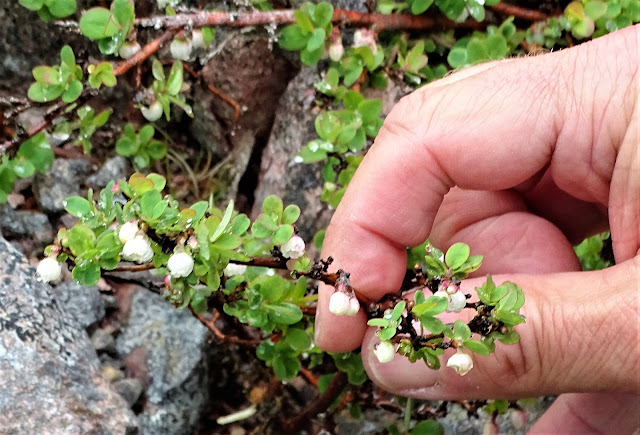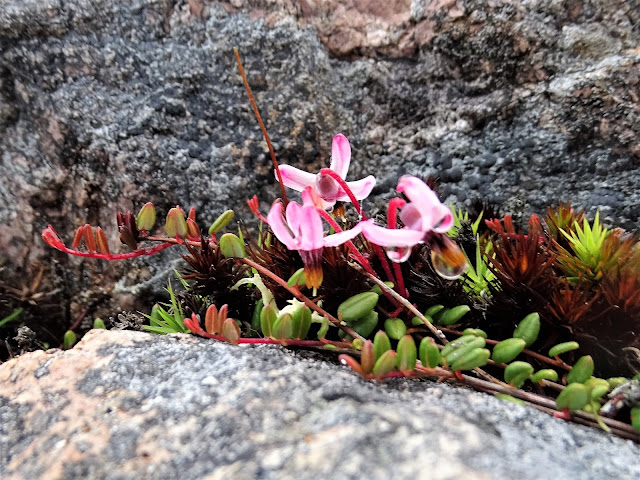 |
| Calopogon tuberosus |
I've known for years about the remarkable displays of orchids in the boreal woodlands of Canada: there was an article in the National Geographic in the middle of the last century showing a field studded with Calopogon on Sable Island, for instance...and though I've seen my share of orchids all over the world, the prospect of seeing these hot pink numbers at the Annual General Meeting of NARGS was an added inducement. I was not disappointed! But there was so much more! (PS: Most of the images in this blog post were taken on Hawk Hill, which I visited several years ago in May: click here to compare the two visits if you have time!--they were very different).
 |
| Vaccinium uliginosum |
 |
| Valccinium vitis-idaea v. minus |
I had seen this species on a previous visit to this same Hawke's Hill near St. Johns a few years ago, only nowhere near bloom yet. And I've seen and grown its taller European cousin. What a treat to find this here and there, here intertwined with the rather local pink rock crowberry (Empetrum eamsii). The crowberries were once classed in their own family, but molecular studies have shown they're Ericads as well.
A more distant view of the same combo...
 |
| Vaccinium oxycoccjus |
 |
| Vaccinium boreale |
 |
| Huperzia sp. |
I believe this is Maianthemum trifolium and not the commoner M. canadense...I had not realized there was yet another member of the genus here until this visit.
I am always intrigued with the bright branches on ericads that one finds almost everywhere they grow--although I believe these may be mycoplasm or otherwise disease induced: diseases gotta live too you know! And it's nice that they're colorful...
I included this to show how low the clouds were when we first arrived. Later in the day the mist burned off and it was gloriously sunny--we were very lucky with weather!
Another view of fog, this time down in the valley...and the fantastic "Canadian carpet" of all manner of little shrubs, mostly ericaceous, but also Junipers and honeysuckles and all manner of cute tiny things!
You shall have to look up my old blog to see the flowers, but even in seed Diapensia lapponica is charming!
If the seed were just a tad riper I'd have been sorely tempted....
Another trophy of the trip was finding Arctous alpina, which I have seen in Alaska as well! Much more delicate than Arctous rubra that grows in Wyoming (although only just barely there)
Here is The Master: Todd Boland who was the Impresario and principal organizer of this meeting. Todd has published a shelf-full of books--all of them superbly illustrated mostly with his own photographs--on many facets of Maritime botany and horticulture. He is chief Horticulturist at the Memorial University's botanical garden--and he's truly a dynamo worth getting to know. He received the prestigious Edgar T. Wherry award at this meeting--in recognition of his groundbreaking work with North American botany. He was always surrounded by a throng of acolytes!
I love the Persian carpet effect of the boreal heathlands: never the same from foot to foot!
Here clubmosses entwined with lichens and shrubs...
Another view of the samel..
I love how colorful the contrasts are, and how bright the russets and silvers are among the green...
And the mosses! Oh yes...I promised orchids didn't I? You shall have to wait until our bog trotting at the next stop for those--but these boreal heathlands are pretty rich in their own right I have found! With their own intricate majesty.




















This post brings back now distant memories of hiking in mountains in the Northeastern U.S. I wish I had some of these shrubs in my garden. The picture in the below link and Gaultheria procumbens is the closest I have at the moment.
ReplyDeletehttps://plus.google.com/u/0/photos/photo/107874019080399894118/6573354567132906178
I am enjoying these posts and hope one day to get there myself. It looks like such an amazing place, not only for the plants, but certainly they are incredible. That Vaccinium is really sweet. Thank you for always sharing, Panayoti.
ReplyDeleteI remember being in AK on a birding tour and I kept looking at the plants on the ground and photographing. It is another world where these tiny trees, shrubs etc grow.
ReplyDelete